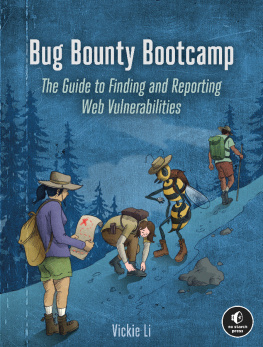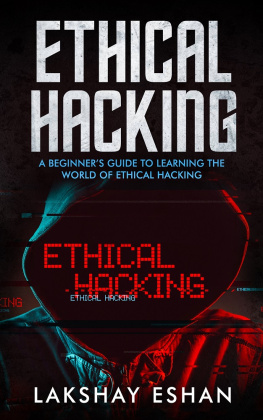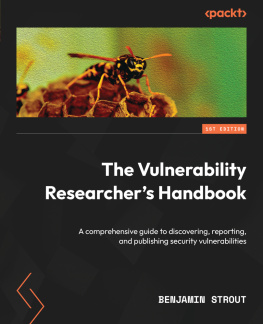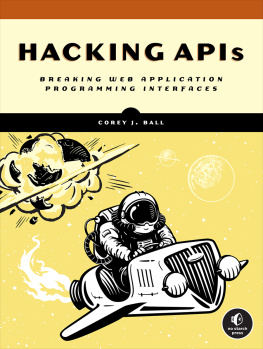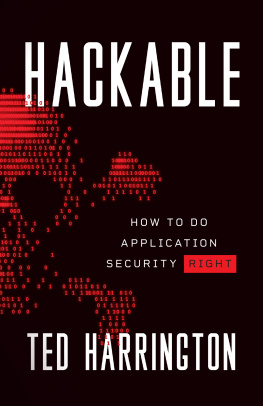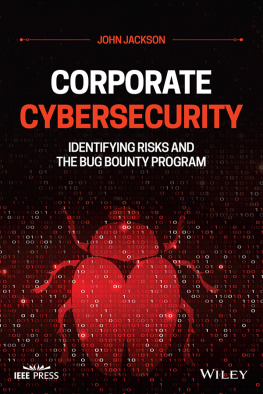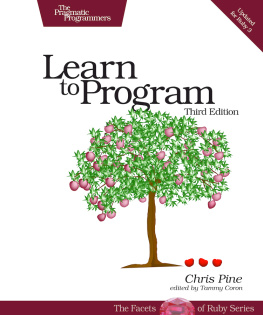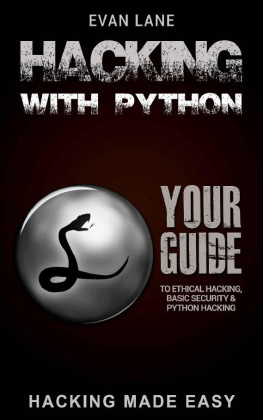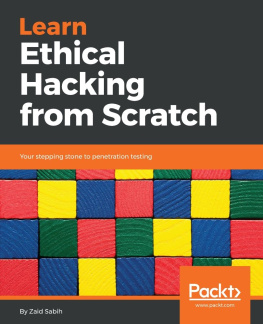
Bug Bounty Bootcamp
The Guide to Finding and Reporting Web Vulnerabilities
Vickie Li

Bug Bounty Bootcamp. Copyright 2021 by Vickie Li.
All rights reserved. No part of this work may be reproduced or transmitted in any form or by any means, electronic or mechanical, including photocopying, recording, or by any information storage or retrieval system, without the prior written permission of the copyright owner and the publisher.
ISBN-13: 978-1-7185-0154-6 (print)
ISBN-13: 978-1-7185-0155-3 (ebook)
Publisher: William Pollock
Production Manager: Rachel Monaghan
Production Editors: Miles Bond and Dapinder Dosanjh
Developmental Editor: Frances Saux
Cover Design: Rick Reese
Interior Design: Octopod Studios
Technical Reviewer: Aaron Guzman
Copyeditor: Sharon Wilkey
Compositor: Jeff Lytle, Happenstance Type-O-Rama
Proofreader: James Fraleigh
For information on book distributors or translations, please contact No Starch Press, Inc. directly:
No Starch Press, Inc.
245 8th Street, San Francisco, CA 94103
phone: 1-415-863-9900; info@nostarch.com
www.nostarch.com
Names: Li, Vickie, author.
Title: Bug bounty bootcamp : the guide to finding and reporting web
vulnerabilities / Vickie Li.
Description: San Francisco : No Starch Press, [2021] | Includes index. |
Identifiers: LCCN 2021023153 (print) | LCCN 2021023154 (ebook) | ISBN
9781718501546 (print) | ISBN 9781718501553 (ebook)
Subjects: LCSH: Web sites--Security measures. | Penetration testing
(Computer security) | Debugging in computer science.
Classification: LCC TK5105.8855 .L523 2021 (print) | LCC TK5105.8855
(ebook) | DDC 025.042--dc23
LC record available at https://lccn.loc.gov/2021023153
LC ebook record available at https://lccn.loc.gov/2021023154
No Starch Press and the No Starch Press logo are registered trademarks of No Starch Press, Inc. Other product and company names mentioned herein may be the trademarks of their respective owners. Rather than use a trademark symbol with every occurrence of a trademarked name, we are using the names only in an editorial fashion and to the benefit of the trademark owner, with no intention of infringement of the trademark.
The information in this book is distributed on an As Is basis, without warranty. While every precaution has been taken in the preparation of this work, neither the author nor No Starch Press, Inc. shall have any liability to any person or entity with respect to any loss or damage caused or alleged to be caused directly or indirectly by the information contained in it.
About the Author
Vickie Li is a developer and security researcher experienced in finding and exploiting vulnerabilities in web applications. She has reported vulnerabilities to firms such as Facebook, Yelp, and Starbucks and contributes to a number of online training programs and technical blogs. She can be found at https://vickieli.dev/, where she blogs about security news, techniques, and her latest bug bounty findings.
About the Tech Reviewer
Aaron Guzman is co-author of IoT Penetration Testing Cookbook and product security lead with Cisco Meraki. He spends his days building security into IoT products and crafting designs that keep users safe from compromise. A co-chair of Cloud Security Alliances IoT Working Group and a technical reviewer for several published security books, he also spearheads many open-source initiatives, raising awareness about IoT hacking and proactive defensive strategies under OWASPs IoT and Embedded Application Security projects. He has extensive public speaking experience, delivering conference presentations, training, and workshops globally. Follow Aaron on Twitter @scriptingxss.
Foreword
Twenty or even ten years ago, hackers like me were arrested for trying to do good. Today, we are being hired by some of the worlds most powerful organizations.
If youre still considering whether or not you are late to the bug bounty train, know that youre coming aboard at one of the most exciting times in the industrys history. This community is growing faster than ever before, as governments are beginning to require that companies host vulnerability disclosure programs, Fortune 500 companies are building such policies in droves, and the applications for hacker-powered security are expanding every day. The value of a human eye will forever be vital in defending against evolving threats, and the world is recognizing us as the people to provide it.
The beautiful thing about the bug bounty world is that, unlike your typical nine-to-five job or consultancy gig, it allows you to participate from wherever you want, whenever you want, and on whatever type of asset you like! All you need is a decent internet connection, a nice coffee (or your choice of beverage), some curiosity, and a passion for breaking things. And not only does it give you the freedom to work on your own schedule, but the threats are evolving faster than the speed of innovation, providing ample opportunities to learn, build your skills, and become an expert in a new area.
If you are interested in gaining real-world hacking experience, the bug bounty marketplace makes that possible by providing an endless number of targets owned by giant companies such as Facebook, Google, or Apple! Im not saying that it is an easy task to find a vulnerability in these companies; nevertheless, bug bounty programs deliver the platform on which to hunt, and the bug bounty community pushes you to learn more about new vulnerability types, grow your skill set, and keep trying even when it gets tough. Unlike most labs and Capture the Flags (CTFs), bug bounty programs do not have solutions or a guaranteed vulnerability to exploit. Instead, youll always ask yourself whether or not some feature is vulnerable, or if it can force the application or its functionalities to do things its not supposed to. This uncertainty can be daunting, but it makes the thrill of finding a bug so much sweeter.
In this book, Vickie explores a variety of different vulnerability types to advance your understanding of web application hacking. She covers the skills that will make you a successful bug bounty hunter, including step-by-step analyses on how to pick the right program for you, perform proper reconnaissance, and write strong reports. She provides explanations for attacks like cross-site scripting, SQL injection, template injection, and almost any other you need in your toolkit to be successful. Later on, she takes you beyond the basics of web applications and introduces topics such as code review, API hacking, automating your workflow, and fuzzing.
For anyone willing to put in the work, Bug Bounty Bootcamp gives you the foundation you need to make it in bug bounties.
Ben Sadeghipour
Hacker, Content Creator, and
Head of Hacker Education at HackerOne
Introduction

I still remember the first time I found a high-impact vulnerability. I had already located a few low-impact bugs in the application I was testing, including a CSRF, an IDOR, and a few information leaks. Eventually, I managed to chain these into a full takeover of any account on the website: I could have logged in as anyone, read anyones data, and altered it however I wanted. For an instant, I felt like I had superpowers.
Next page
